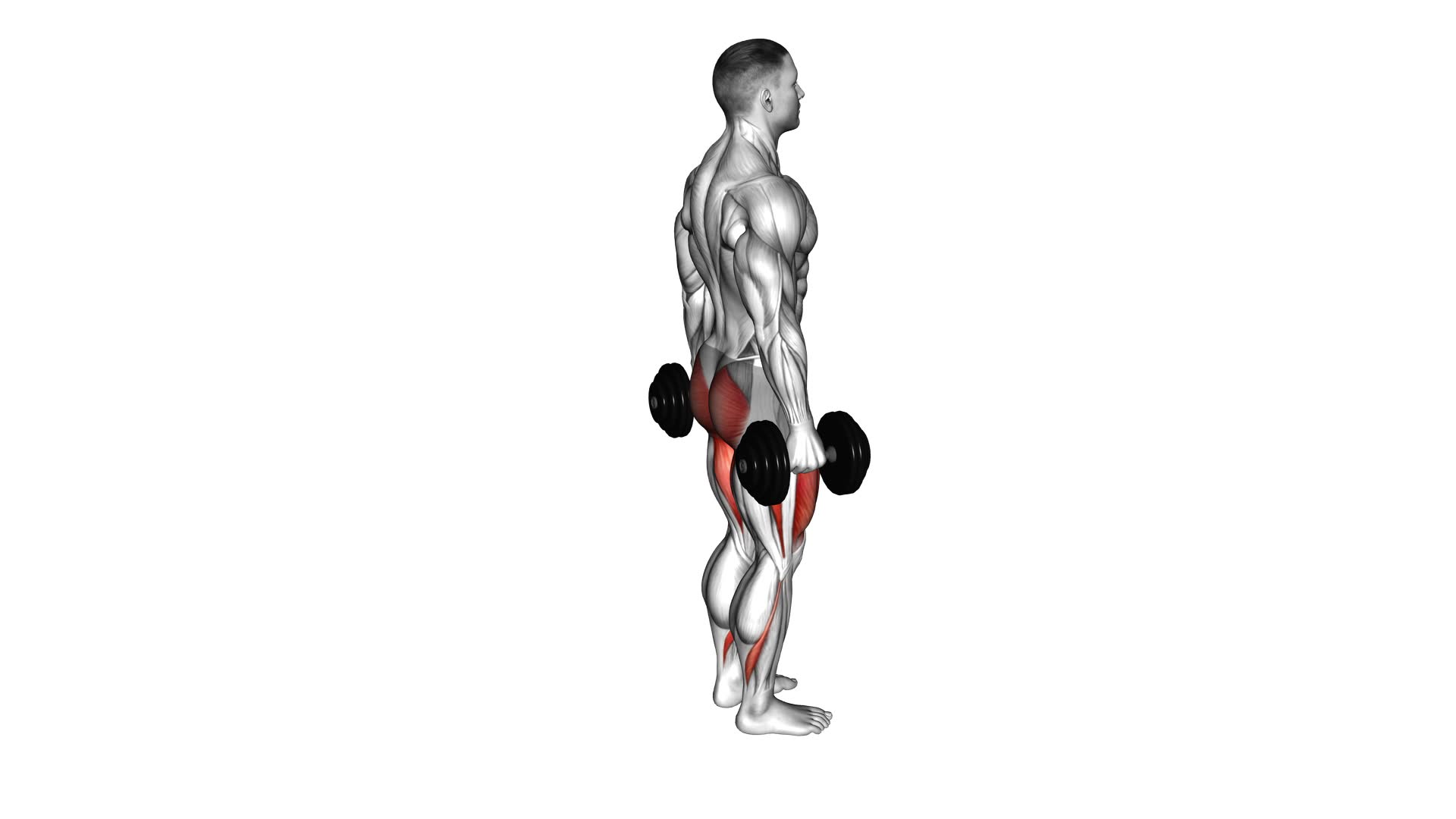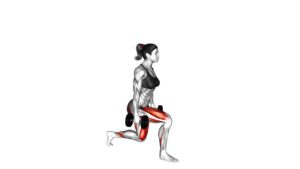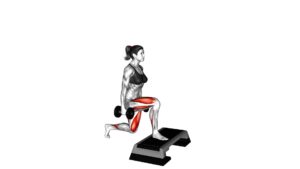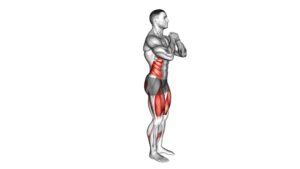Dumbbell Rear Lunge – Video Exercise Guide & Tips

Looking to amp up your leg workout? Get ready to feel the burn with the dumbbell rear lunge! This exercise targets your quads, glutes, and hamstrings, helping you build lower body strength and definition.
Watch This Exercise Video
In this video exercise guide, we'll walk you through the proper form and technique, provide variations to keep your routine fresh, and offer tips to maximize your results.
So grab your dumbbells and get ready to lunge your way to stronger, more toned legs!
Key Takeaways
- Dumbbell Rear Lunges target multiple muscle groups: glutes, hamstrings, and quadriceps.
- Engaging core muscles during Dumbbell Rear Lunges improves stability and balance.
- Dumbbell Rear Lunges enhance overall mobility and functional strength.
- Incorporating Dumbbell Rear Lunges into weight loss or fitness programs can increase calorie burn and promote fat loss.
Benefits of Dumbbell Rear Lunges
You can experience several benefits from incorporating dumbbell rear lunges into your workout routine.
Dumbbell rear lunges are a highly effective exercise that target multiple muscle groups and promote overall strength and stability. One of the main benefits of dumbbell rear lunges is the muscle activation they provide. This exercise primarily targets the glutes, hamstrings, and quadriceps, helping to strengthen and tone these muscles.
Dumbbell rear lunges also engage the core muscles, including the abdominals and lower back, as they work to stabilize the body during the movement. This not only improves core strength but also enhances overall balance and coordination.
In addition to targeting specific muscle groups, dumbbell rear lunges also offer functional benefits. By mimicking movements used in everyday activities, such as walking or climbing stairs, this exercise helps to improve overall mobility and functional strength.
Furthermore, incorporating dumbbell rear lunges into your workout routine can also help to increase calorie burn and promote fat loss. As a compound exercise, dumbbell rear lunges require the use of multiple muscles, resulting in a higher calorie expenditure compared to isolation exercises. This makes them a valuable addition to any weight loss or fitness program.
Proper Form and Technique
To ensure proper form and technique during dumbbell rear lunges, it's important to maintain a stable and aligned posture throughout the exercise. Here are some tips for technique and common mistakes to avoid:
- Keep your chest up: It's common to lean forward during the lunge, but this can strain your lower back. Focus on keeping your chest lifted and your shoulders back throughout the movement.
- Step back far enough: When stepping back into the lunge, make sure your front knee is directly above your ankle and your back knee is hovering just above the ground. Avoid letting your front knee extend past your toes.
- Engage your core: To maintain stability, engage your core muscles throughout the exercise. This will help you maintain balance and prevent any unnecessary strain on your back.
- Control the movement: Avoid rushing through the lunge and instead, focus on a slow and controlled movement. This will help you maintain proper form and maximize the benefits of the exercise.
By following these tips, you can ensure that you're performing dumbbell rear lunges with proper form and technique.
Now, let's move on to the next section to explore some variations to mix up your routine.
Variations to Mix Up Your Routine
To add variety to your routine, consider incorporating different variations of the dumbbell rear lunge exercise. By introducing these variations, you can target different muscle groups and challenge your body in new ways.
One option is to use different equipment during the exercise. Instead of using dumbbells, you can try using a barbell or kettlebells to add intensity and engage your muscles differently.
Another option is to incorporate balance challenges into the exercise. You can do this by performing the rear lunge on an unstable surface, such as a BOSU ball or a balance board. This won't only work your leg muscles but also enhance your stability and core strength.
Additionally, you can try performing the rear lunge with a twist, where you rotate your torso towards the side of the lunging leg. This variation will engage your oblique muscles and further enhance your overall strength and stability.
By incorporating these different equipment options and balance challenges, you can keep your workouts interesting and continue to challenge your body.
Now, let's move on to the next section and discuss some common mistakes to avoid.
Common Mistakes to Avoid
Avoiding common mistakes is crucial when performing the dumbbell rear lunge exercise. To ensure you're maximizing the benefits of this exercise and reducing the risk of injury, pay attention to the following common mistakes and make sure you're using proper technique:
- Lunging too far forward: When performing the dumbbell rear lunge, it's important to maintain proper form and not lunge too far forward. Keep your front knee directly above your ankle and avoid letting it extend past your toes.
- Leaning forward or rounding your back: To prevent strain on your lower back, make sure to keep your torso upright and avoid leaning forward or rounding your back during the exercise. Engage your core muscles to maintain stability.
- Not stepping back far enough: Take a big enough step backward to ensure your front knee is at a 90-degree angle when you lower into the lunge position. This will help engage your glutes and hamstrings effectively.
- Neglecting proper alignment: Maintain proper alignment by keeping your shoulders back and down, chest lifted, and gaze forward. This will help you maintain balance and stability throughout the exercise.
By avoiding these common mistakes and focusing on using proper technique, you can perform the dumbbell rear lunge safely and effectively.
Now, let's move on to the next section where we'll discuss some tips for getting the most out of your workout.
Tips for Getting the Most Out of Your Workout
To maximize your workout and achieve optimal results, incorporate the following tips into your dumbbell rear lunge routine.
First and foremost, it's crucial to maintain proper form throughout the exercise. This not only ensures your safety but also maximizes the engagement of the targeted muscles. Keep your back straight, shoulders relaxed, and core engaged.
When performing the rear lunge, focus on driving through your front heel to activate your glutes and hamstrings effectively.
Another tip for maximizing results is to gradually increase the weight of the dumbbells as you progress. This will challenge your muscles and promote strength and endurance gains. However, it's essential to find the right balance between challenging yourself and maintaining proper form. Overloading with excessive weights can lead to injury and compromise your workout efficiency.
In addition, incorporating variations into your dumbbell rear lunge routine can further enhance your results. Try performing walking lunges or adding a rotation at the bottom of the lunge to engage different muscle groups and increase the overall intensity of the exercise.
Lastly, don't forget to include proper warm-up and cool-down exercises before and after your dumbbell rear lunge routine. This helps prepare your muscles for the workout and aids in recovery, ultimately improving workout efficiency and reducing the risk of injury.
Frequently Asked Questions
How Many Reps and Sets Should I Do for Dumbbell Rear Lunges?
To determine the number of reps and sets for dumbbell rear lunges, you need to consider your fitness goals and current fitness level. Start with 2-3 sets of 8-12 reps per leg and adjust accordingly.
Dumbbell rear lunges are an effective lower body exercise that targets multiple muscles, including the glutes, hamstrings, and quadriceps. They can also improve balance and stability.
Incorporating variations and gradually increasing intensity can help you progress and maximize the benefits of dumbbell rear lunges.
Can Dumbbell Rear Lunges Help Me Lose Weight?
Dumbbell rear lunges can be effective for weight loss when incorporated into a full body workout routine. These lunges engage multiple muscle groups, including your glutes, hamstrings, and quadriceps, which can help increase your overall calorie burn.
Additionally, the added resistance from the dumbbells increases the intensity of the exercise, leading to greater calorie expenditure. To maximize weight loss, consider combining dumbbell rear lunges with other compound exercises and maintaining a balanced diet.
Are Dumbbell Rear Lunges Suitable for Beginners?
Dumbbell rear lunges can be suitable for beginners, as they provide a challenging workout while targeting multiple muscle groups. If you're new to this exercise, there are modifications you can make to ensure proper form and reduce strain on your joints.
The benefits of dumbbell rear lunges for beginners include improved lower body strength, stability, and balance. Incorporating this exercise into your routine can help you progress towards more advanced movements and achieve your fitness goals.
Can Dumbbell Rear Lunges Help Improve My Balance?
Dumbbell rear lunges can greatly improve your stability and coordination. By engaging multiple muscle groups, such as your quads, glutes, and hamstrings, these lunges challenge your balance and force you to control your body's movements.
To increase the challenge, you can try variations like adding a twist at the top or performing them on an unstable surface. These variations require even more stability and coordination, helping you further enhance these skills while strengthening your lower body.
Should I Use a Specific Weight for Dumbbell Rear Lunges or Can I Adjust It Based on My Fitness Level?
You can adjust the weight for dumbbell rear lunges based on your fitness level. Using a specific weight isn't necessary; you have the flexibility to choose what works best for you. This allows you to gradually increase the weight as you become stronger and more comfortable with the exercise.
Incorporating dumbbells into your rear lunges offers several benefits. First, it increases the intensity of the exercise, making it more challenging and effective for building strength. Second, it helps to build muscle strength, particularly in the lower body, including the glutes, hamstrings, and quadriceps. Lastly, it improves overall balance and stability, as you have to engage your core muscles to maintain proper form while holding the dumbbells.
Conclusion
In conclusion, incorporating dumbbell rear lunges into your workout routine can provide numerous benefits for your lower body strength and stability. By maintaining proper form and technique, you can maximize the effectiveness of this exercise and avoid common mistakes.
Additionally, adding variations to your routine can keep your workouts interesting and challenge your muscles in different ways. Remember to always listen to your body and adjust the weight and intensity as needed.
Keep up the hard work and enjoy the results of your efforts!

Author
Years ago, the spark of my life’s passion ignited in my mind the moment I stepped into the local gym for the first time. The inaugural bead of perspiration, the initial endeavor, the very first surge of endorphins, and a sense of pride that washed over me post-workout marked the beginning of my deep-seated interest in strength sports, fitness, and sports nutrition. This very curiosity blossomed rapidly into a profound fascination, propelling me to earn a Master’s degree in Physical Education from the Academy of Physical Education in Krakow, followed by a Sports Manager diploma from the Jagiellonian University. My journey of growth led me to gain more specialized qualifications, such as being a certified personal trainer with a focus on sports dietetics, a lifeguard, and an instructor for wellness and corrective gymnastics. Theoretical knowledge paired seamlessly with practical experience, reinforcing my belief that the transformation of individuals under my guidance was also a reflection of my personal growth. This belief holds true even today. Each day, I strive to push the boundaries and explore new realms. These realms gently elevate me to greater heights. The unique combination of passion for my field and the continuous quest for growth fuels my drive to break new ground.







